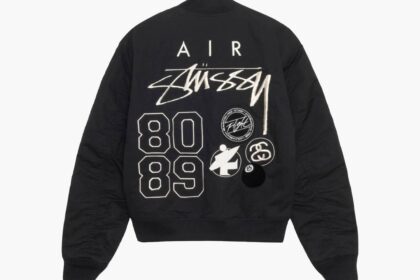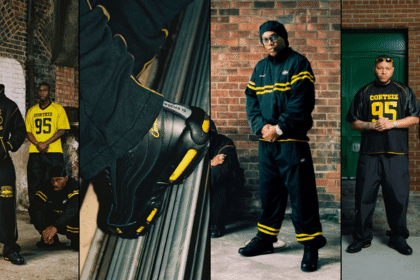Stüssy is more than just a clothing brand—it’s a cultural phenomenon that shaped the course of streetwear history. Founded in the early 1980s by surfboard shaper Shawn Stüssy, the label started as a small surf-inspired project but quickly evolved into a global fashion movement. From its humble beginnings on the beaches of Laguna Beach, California, to its influential role in music, art, and youth culture, Stüssy’s journey is filled with defining moments. Let’s take a look at the key milestones in Stüssy’s fashion timeline that made it the legendary brand it is today.
The Birth of the Stüssy Logo (1980):
The story began in 1980, when Shawn Stüssy, a local surfboard shaper, began scrawling his now-iconic signature on surfboards. The handwritten graffiti-style logo became the brand’s identity, representing a raw, authentic, and laid-back vibe. To promote his surfboards, Shawn printed the logo on T-shirts and shorts, which he sold directly from his car—unintentionally planting the seeds of a streetwear empire.
Official Launch of the Brand (1984):
By 1984, Shawn Stüssy realized there was serious demand for his clothing. He officially launched the Stüssy brand, expanding beyond surf gear into apparel that merged surf, skate, and punk styles. The collection included graphic tees, caps, and shorts—clothing that spoke to California’s youth and resonated with a growing global audience.
First International Distribution (Mid-1980s):
Stüssy’s popularity quickly spread beyond California. In the mid-1980s, the brand started distributing internationally, particularly in Japan and Europe, where its rebellious, anti-mainstream attitude found a perfect audience. This early global expansion helped Stüssy stand out from other local streetwear labels.
The Rise of the Stüssy Tribe (Late 1980s – Early 1990s):
One of the most defining moves in Stüssy’s history was the formation of the Stüssy Tribe—a loose collective of influential DJs, artists, and creatives. Members like DJ Hiroshi Fujiwara, James Jebbia (later founder of Supreme), and Goldie wore and promoted the brand. This crew wasn’t just marketing; they embodied the lifestyle Stüssy was selling. The Tribe’s influence helped embed the brand into underground music scenes from hip-hop to house.
The Cross-Cultural Fusion of Streetwear (1990s)
In the early 1990s, Stüssy began blending influences from surfing, skateboarding, hip-hop, and reggae culture—a mix that became the DNA of modern streetwear. This era saw the release of baggy jeans, bucket hats, and oversized tees with bold graphic prints, appealing to youth across subcultures. By merging West Coast surf vibes with East Coast hip-hop aesthetics, Stüssy became a true cultural hybrid.
Collaborations Before They Were Cool (Mid-1990s):
Long before collaborations became a standard streetwear marketing tactic, Stüssy was working with other brands and artists. These early partnerships, such as with Nike and G-Shock, proved Stüssy’s ability to innovate and connect with multiple style communities. Each collaboration was limited, making them highly sought-after among collectors.
The Japanese Market Boom (Late 1990s):
Japan became one of Stüssy’s strongest markets in the late 1990s. The brand opened Stüssy Chapter stores in Tokyo and other major cities, creating a retail experience that blended fashion with music and art. Japanese streetwear culture embraced Stüssy as both a fashion statement and a collector’s item, fueling its longevity.
Shawn Stüssy Steps Down (1996):
In 1996, Shawn Stüssy unexpectedly stepped down from the brand, citing personal reasons. Many feared the brand would lose its authenticity without its founder. However, under the leadership of Frank Sinatra Jr. (not the singer, but Shawn’s business partner), Stüssy continued to grow while staying true to its roots.
2000s: Streetwear Goes Mainstream
As streetwear entered the 2000s, brands like Supreme, BAPE, and Stüssy became part of a global fashion conversation. Stüssy capitalized on this wave, releasing seasonal collections that retained its underground appeal while appealing to a new generation. The brand also began reissuing vintage designs, tapping into the growing nostalgia trend.
Limited Drops & Collector Culture (Mid-2000s):
Stüssy embraced the “limited drop” strategy, releasing small quantities of exclusive items to create hype. This scarcity model strengthened its cult following and kept demand high. Many early Stüssy releases from this period are now considered grails in the streetwear resale market.
Big Collaborations with High Fashion (2010s):
The 2010s marked a new phase, as high fashion began to embrace streetwear. Stüssy collaborated with Dior, Comme des Garçons, and Dover Street Market, blurring the lines between luxury and street style. These partnerships expanded Stüssy’s influence into the luxury fashion world without sacrificing authenticity.
35th Anniversary & New Creative Direction (2015):
In 2015, Stüssy celebrated its 35th anniversary with a series of special releases and collaborations. This milestone reaffirmed the brand’s status as a streetwear pioneer. Around this time, the brand also refined its aesthetic, moving towards minimalist, premium basics while keeping graphic designs in rotation.
Vintage Stüssy Resurgence (Late 2010s):
A new wave of fashion enthusiasts rediscovered vintage Stüssy pieces, particularly those from the late 1980s and 1990s. The thrifting and resale market fueled renewed interest in the brand, making its vintage logo tees, work jackets, and caps hot commodities.
Pandemic-Era Popularity Surge (2020):
During the 2020 pandemic, streetwear saw a huge boost as people embraced casual, comfortable clothing. Stüssy’s hoodies, sweatpants, and oversized tees became essentials for home and streetwear fashion alike. The brand leveraged online drops and social media hype to maintain momentum.
40th Anniversary Celebration (2020):
In 2020, Stüssy marked its 40th anniversary with a year-long celebration, including re-releases of iconic designs and special collaborations with Nike, Our Legacy, and more. This milestone cemented Stüssy’s four-decade reign in the streetwear world.
Stüssy Today: Timeless Relevance
Today, Stüssy remains one of the few streetwear brands that has maintained cultural relevance for over 40 years. With a balance of heritage designs and fresh, innovative releases, the brand continues to influence both underground style and mainstream fashion.
From a surfboard logo to a global streetwear powerhouse, Stüssy’s timeline is a masterclass in staying true to your roots while adapting to cultural shifts. Each milestone reflects the brand’s ability to bridge communities, innovate before trends hit the mainstream, and maintain a loyal following across generations.
Stüssy’s journey proves that authenticity, creativity, and community are the true keys to fashion longevity—and its story is far from over.





